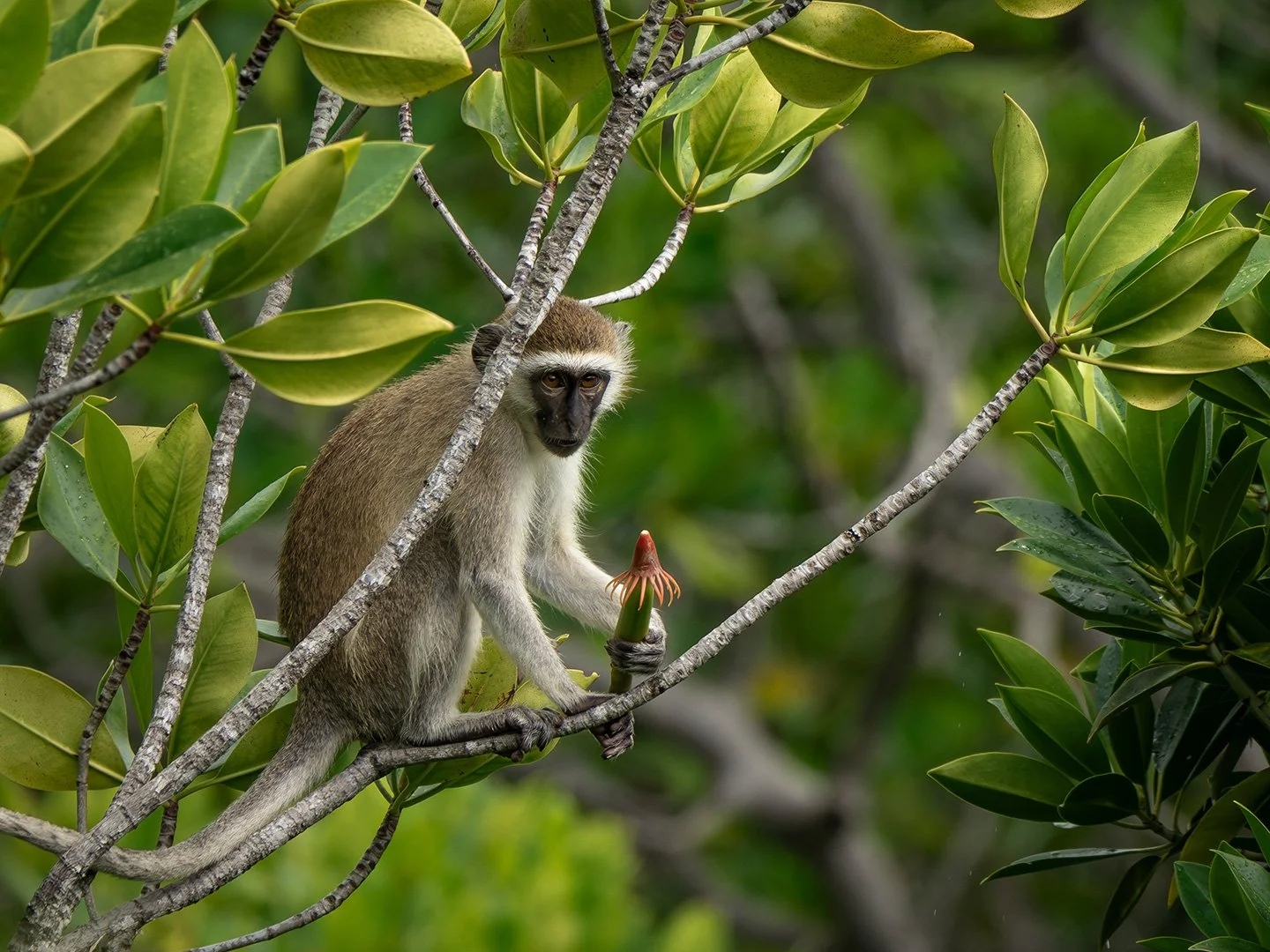Observing Primates in the Wild
By Safina Center Fellow Alex Chege
A subadult vervet monkey forages on the caloric dense fruit of a large-leafed orange mangrove (Bruguiera gymnorhiza). Vervets are incredibly resourceful in their dynamic food preferences that reflect locally available food sources in novel settings. ©Alex Chege
Primatologists are researchers who study primates—our closest living relatives. Although primatologists are concerned with studying the behavior of wild primates for many applications including conservation, others study primates as analogous living examples of the behavioral origins of humans and as a window into the behavior of our early ancestors. Like (us) humans, primates are social, ingenious and resourceful, adapting to various environments, and these qualities have made them one of the most abundant and geographically widespread mammalian Orders.
Observing primate behavior, especially in the wild, can oftentimes be challenging due to the complex ways primates interact with their ecological and social environments. Behaviors can be reliable indicators of factors such as milestones in development, adaptation to local conditions, an individual’s temperament or rank within a social group, and even strategies to deal with competition amongst others for valuable resources. However, conducting fieldwork in remote and difficult to access locations—which is often typical for many wild populations—places immense importance on collecting behavioral data in ways that can be replicated between observers and most ideally that is comparable between different study sites or similar species. Because of this, the field of primatology has benefited from standardizing methods that allow behavior to be observed and recorded in meaningful ways.
Thanks to the Safina Center Launchpad Fellowship, I recently spent two months at my field research site in Kenya observing the foraging behavior of wild vervet monkeys. Below are some examples of behaviors I observed in my study population that illustrate how these seemingly subtle actions can provide critical insights into primate ecology and by extension, our own evolutionary history.
Weaning as a developmental milestone. ©Alex Chege
Among mammals, weaning is a major developmental milestone. Being weaned from mother’s milk is an incredibly stressful experience for infants, as this conflict with their mother forces independence upon the weaned infant as seen in the video. This conflict arises since weaning is energetically beneficial for mothers, but it is stressful for their weaned offspring. Primatologists use weaning as a developmental milestone to identify what circumstances accelerate weaning and under what conditions mothers prioritize weaning their offspring over continuing to nurture and invest in a mature infant. Since weaned infants are now expected to forage for themselves, in some primates, when weaning occurs can coincide with times when food within the environment is most plentiful—but this not the case for all species. The age when weaning occurs can vary between species and even populations—e.g., if a species differs in the degree to which mothers prolong investment in their offspring, or if environments vary in the relative abundance of foods available for newly weaned juveniles.
The challenges of finding and keeping food. ©Alex Chege
For independent individuals, searching for food is another challenging aspect of daily activity. Finding food sources is crucial, as the availability of food options can change depending on the season or if a population is located in an atypical environment—such is the case for populations inhabiting coastal areas. When an individual locates food items that may be valuable, this can oftentimes result in competition for access to these foods. One can choose to forage away from others to avoid competition, but this also places them at greater risk to predators if preferred foods are located away from the safety of the whole group.
You scratch my back… Primatologists record grooming patterns to understand the context and strength of social relationships among group living individuals. ©Alex Chege
Finally, grooming is a very typical behavior that influences a primate’s social environment. Grooming can be mutually beneficial when the removal of parasites is performed by others, and this can serve as a form of social interaction and intimacy between group members. Grooming exchanges (or grooming networks) can be indicative of how connected an individual is to other group members, whereas grooming frequencies and duration can also be indicative of the strength of a relationship between two individuals. When primatologists contextualize grooming, they can identify circumstances such as when grooming acts are initiated. Grooming attempts can be initiated to begin relationships, resolve recent conflict, or even performed prior to anticipated periods of conflict to solidify alliances—e.g., grooming can strengthen coalitions during times when infanticidal males may be motivated to take over a group and usurp its predecessors.
Observing animal behavior in the wild is captivating for many enthusiasts, but a greater depth of insight comes when we begin to understand the context—why and when individuals engage in specific behaviors, and how these actions contribute to survival. This perspective not only enhances our appreciation of the animal world, but also offers valuable lessons on the roots of human behavior.

